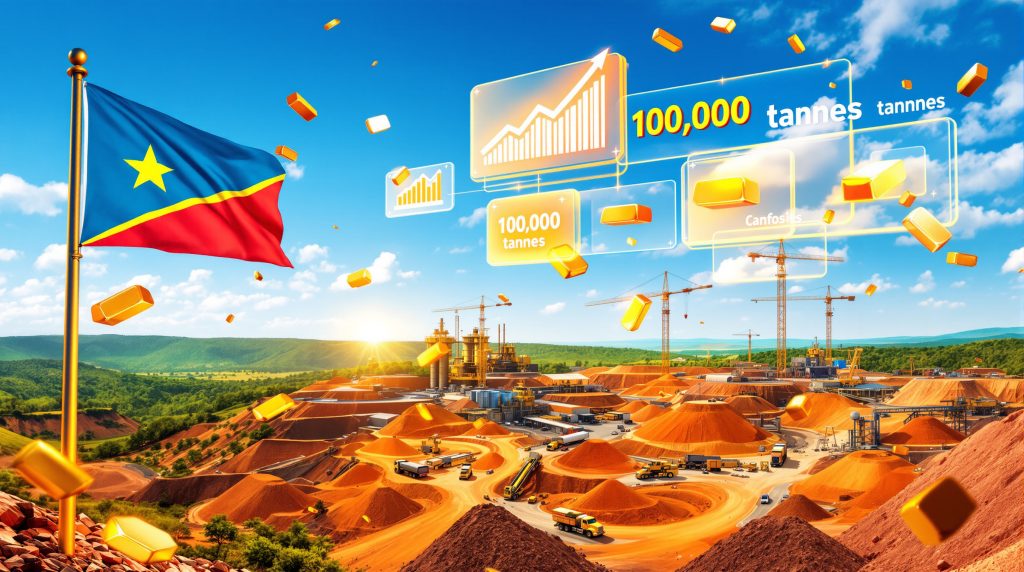Understanding CMOC's Strategic Investment Framework
China Molybdenum Co. (CMOC Group) stands as one of the most significant players in the global copper mining landscape, operating diverse mining assets across multiple continents. The company's latest strategic move involves a substantial $1.08 billion investment in expanding its Kisanfu Mining (KFM) facility in the Democratic Republic of Congo, representing one of the largest copper expansion projects announced in recent years. This CMOC Congo copper mine expansion demonstrates the company's commitment to meeting growing global demand.
This massive capital commitment targets the addition of approximately 100,000 metric tons of annual copper production capacity through a second phase development scheduled to commence operations in 2027. The timing proves particularly strategic, as the first phase of KFM operations achieved full capacity in 2023, providing CMOC with operational data and infrastructure foundation to support the ambitious expansion.
CMOC maintains 71.25% ownership of the KFM project through its Hong Kong-based subsidiary structure, a corporate arrangement that provides regulatory flexibility and operational control while accommodating other stakeholders in the remaining ownership percentage. Furthermore, this investment represents a continuation of CMOC's broader African mining strategy, building upon their existing operations at the Tenke Fungurume mine, also located in Congo.
The strategic rationale behind this expansion extends beyond simple capacity addition. Global copper markets face mounting supply pressure from widespread mine disruptions, including the suspension of major operations like Freeport's Grasberg project in Indonesia. This supply constraint environment creates favorable conditions for new production capacity, particularly from established operators with proven regional expertise.
Production Capacity Analysis and Technical Infrastructure
The KFM expansion will fundamentally transform the facility's contribution to regional and global copper output. While specific baseline production figures for Phase 1 operations remain proprietary, the 100,000 metric ton annual increase represents a substantial capacity addition that positions the mine among significant African copper producers.
To contextualise this expansion, the additional 100,000 tonnes annually represents approximately 0.4% of global copper production, based on worldwide output of approximately 21 million metric tons. While this percentage may appear modest, the timing during supply shortage periods amplifies the strategic importance of every additional tonne brought to market. In addition, experts suggest this timing aligns perfectly with broader copper price prediction insights regarding future market dynamics.
Technical Infrastructure Requirements
The expansion necessitates comprehensive infrastructure development across multiple operational areas:
• Mining Technology Systems: Enhanced extraction equipment and automation technologies to support increased ore processing volumes
• Processing Facility Expansion: Upgraded concentrators, flotation circuits, and refining capabilities to handle higher throughput requirements
• Transportation Infrastructure: Improved logistics networks for moving increased copper concentrate volumes from mine to export terminals
• Power Generation Systems: Additional electrical capacity to support expanded mining and processing operations
• Water Management Infrastructure: Enhanced water treatment and recycling systems to support larger-scale operations
The technical complexity of expanding an operational mine while maintaining current production levels requires sophisticated project management and phased implementation strategies. CMOC's experience from Phase 1 development provides valuable operational knowledge for managing these technical challenges.
Global Copper Supply Chain Dynamics
The timing of CMOC's expansion announcement reflects acute awareness of evolving global copper supply dynamics. Multiple factors converge to create supply constraints that make new production capacity particularly valuable in current market conditions. Consequently, the global copper supply forecast indicates significant gaps that projects like this expansion aim to address.
Supply Shortage Indicators
Global copper markets face mounting pressure from several simultaneous disruptions:
• Indonesia's Grasberg Project Suspension: One of the world's largest copper operations remains suspended, removing significant production capacity from global markets
• Aging Mine Infrastructure: Many established copper mines face declining ore grades and increased production costs
• Permitting Delays: New mine developments encounter extended regulatory approval processes, delaying capacity additions
• Labor Disruptions: Strike activity at major copper operations creates periodic supply interruptions
These supply constraints occur precisely as global copper demand accelerates due to energy transition requirements. Electric vehicle manufacturing alone requires approximately 83-100 kilograms of copper per vehicle, compared to just 23 kilograms in conventional automobiles.
Energy Transition Demand Surge
The International Energy Agency projects copper demand for clean energy applications will reach 21 million tonnes annually by 2040, more than doubling 2020 consumption levels. This demand growth stems from several key sectors:
| Application | Copper Requirement | Growth Driver |
|---|---|---|
| Electric Vehicles | 83-100 kg per vehicle | EV adoption acceleration |
| Solar PV | 8 tonnes per MW capacity | Renewable energy expansion |
| Wind Turbines | 5 tonnes per MW capacity | Grid modernisation needs |
| Battery Storage | Variable by technology | Energy storage deployment |
CMOC's KFM expansion addresses both copper and cobalt supply needs, as both facilities produce these complementary metals essential for battery production and renewable energy infrastructure. The DRC's Katanga Province contains approximately 50% of global cobalt reserves, making the co-production model economically efficient and strategically valuable.
Financial Structure and Risk Assessment
The $1.08 billion investment commitment represents one of the largest single mining expansion projects announced by a Chinese company in recent years. However, this substantial capital allocation comes with clearly acknowledged risk factors that could impact project returns and operational success.
Investment Structure Analysis
CMOC's ownership through its Hong Kong-based subsidiary provides several structural advantages:
• Regulatory Flexibility: Hong Kong corporate structure offers established legal framework for international mining investments
• Tax Optimisation: Potential for favourable tax treatment on mining revenues and capital gains
• Currency Management: USD-denominated operations provide some protection against local currency volatility
• Capital Markets Access: Enhanced ability to raise project financing through Hong Kong capital markets
The 71.25% majority stake ensures operational control while the remaining 28.75% ownership suggests partnership arrangements that may provide local expertise, regulatory relationships, or additional capital contributions.
Risk Factor Analysis
CMOC explicitly acknowledges two primary risk categories that could impact project success:
Commodity Price Volatility Risk: Copper and cobalt prices experience significant fluctuations based on global economic conditions, industrial demand, and supply disruptions. The company's investment assumes sustained copper pricing that supports profitable operations at projected production costs.
Political and Economic Uncertainty: The Democratic Republic of Congo presents operational challenges including:
• Regulatory Environment Changes: Potential modifications to mining laws, tax policies, or foreign investment regulations
• Currency Volatility: Congolese Franc fluctuations against USD can impact local operational costs
• Infrastructure Stability: Power grid reliability, transportation networks, and port access affecting consistent operations
• Social Licence Maintenance: Community relations and local employment requirements influencing operational continuity
Despite these acknowledged risks, CMOC's existing operations at Tenke Fungurume demonstrate the company's ability to navigate DRC's operational environment successfully. This operational experience provides valuable risk mitigation knowledge for the KFM expansion.
Comparative Analysis with Global Copper Projects
CMOC's KFM expansion demonstrates significantly different cost structures and timelines compared to copper projects in developed markets, reflecting the economic advantages of operating in emerging market jurisdictions with established mining infrastructure. Similarly, US copper investment insight reveals contrasting approaches to copper development across different regions.
Capital Intensity Comparison
| Project | Investment | Annual Capacity Addition | Cost per Tonne | Timeline |
|---|---|---|---|---|
| CMOC KFM Phase 2 | $1.08 billion | 100,000 tonnes | $10,800/tonne | 2027 launch |
| BHP Olympic Dam | $3.5 billion | 65,000 tonnes | $53,846/tonne | 2028-2030 |
| Freeport Grasberg | $2.8 billion | Variable (suspended) | Not applicable | Suspended |
The dramatic cost differential between CMOC's project and BHP's Olympic Dam expansion reflects several key factors:
• Labour Cost Variations: Significantly lower wage structures in Congo versus Australia
• Regulatory Compliance Costs: Less stringent environmental and safety requirements in emerging markets
• Infrastructure Utilisation: KFM expansion builds upon existing Phase 1 infrastructure, reducing total capital requirements
• Permitting Timelines: Faster regulatory approval processes enabling more efficient project execution
Project Risk Profiles
Each major copper expansion faces distinct risk profiles based on jurisdiction, development stage, and market conditions:
CMOC KFM (Congo): Primary risks include political stability, currency volatility, and infrastructure reliability, offset by low operational costs and established mining presence.
BHP Olympic Dam (Australia): Lower political risk but significantly higher labour and compliance costs, with complex technical challenges for underground expansion.
Freeport Grasberg (Indonesia): Suspended due to declining ore grades and project economics challenges, illustrating the risks of aging mine expansions.
Copper Price Impact and Market Implications
The addition of 100,000 tonnes annually to global copper supply occurs at a critical juncture in commodity market dynamics. While representing approximately 0.48% of global production, the timing during supply constraints amplifies the market impact beyond simple percentage calculations.
Supply-Demand Rebalancing Effects
Current copper market dynamics show global demand of approximately 21.6 million tonnes against production of roughly 21 million tonnes, creating a structural deficit that supports pricing. The IEA projects annual demand growth of 2-3% driven primarily by energy transition applications.
CMOC's additional 100,000 tonnes helps address this supply gap, potentially moderating price increases that would otherwise result from tightening market conditions. The company's 2027 launch timeline aligns with projected periods of greatest supply constraint.
Long-term Price Stabilisation Potential
The KFM expansion contributes to longer-term copper price stability through several mechanisms:
• Supply Security Enhancement: Diversifies global copper supply sources, reducing dependence on traditional producing regions
• Cost Curve Impact: If KFM Phase 2 operates at lower costs than marginal global producers, it supports sustainable pricing levels
• Market Confidence: Demonstrates continued private sector investment in copper capacity, encouraging additional development projects
However, the expansion's price impact remains limited by scale. At 0.48% of global production, KFM Phase 2 provides meaningful but not transformative supply additions. Sustained copper price moderation requires multiple projects of similar scale achieving production targets on schedule.
Operational Excellence and Community Integration
CMOC's expansion strategy extends beyond technical infrastructure to encompass comprehensive operational management addressing workforce development, environmental compliance, and community relationship maintenance essential for long-term success in the DRC operating environment. Furthermore, this approach aligns with broader trends in copper and uranium investment strategies.
Local Partnership Strategy
The company's approach to expanding operations emphasises sustainable integration with local communities and economic development:
• Employment Creation: Phase 2 expansion will generate direct employment opportunities in mining, processing, and support services
• Skills Development: Technical training programmes for local personnel in advanced mining technologies and equipment operation
• Supply Chain Integration: Preference for local suppliers and service providers where quality and reliability standards can be met
• Infrastructure Investment: Contributions to regional transportation, power, and communication infrastructure benefiting broader communities
Environmental and Sustainability Framework
Modern copper mining operations require comprehensive environmental management systems addressing water usage, waste management, and ecosystem protection:
• Water Management Systems: Advanced water treatment and recycling technologies minimising environmental impact
• Waste Rock Management: Engineered storage facilities preventing groundwater contamination and surface runoff issues
• Biodiversity Protection: Environmental monitoring and habitat preservation programmes in operational areas
• Carbon Footprint Reduction: Energy efficiency improvements and renewable power integration where feasible
CMOC's existing operations provide environmental management experience applicable to Phase 2 expansion, though increased scale requires proportional enhancement of environmental protection systems.
Geopolitical Implications for Critical Minerals Security
The CMOC expansion represents a significant development in global critical minerals geopolitics, highlighting China's strategic approach to securing supply chains essential for technological and economic competitiveness. Additionally, CMOC to invest $1.1B to expand Congo copper mine as reported by mining industry publications, underscores the scale of this commitment.
China-Africa Mining Partnership Evolution
CMOC's investment exemplifies the broader China-Africa mining relationship characterised by:
• Infrastructure Investment: Chinese companies provide capital for mining infrastructure development in exchange for long-term supply agreements
• Technology Transfer: Advanced mining technologies deployed in African operations, enhancing regional technical capabilities
• Market Integration: African mineral production increasingly integrated into Chinese manufacturing and export supply chains
• Economic Development: Mining investments contribute to African economic development while securing Chinese resource requirements
Strategic Resource Competition
The expansion occurs within broader global competition for critical minerals security:
• Western Response: European and North American initiatives to diversify critical minerals supply sources away from Chinese-controlled operations
• Supply Chain Resilience: Efforts to establish alternative supply chains for copper and cobalt essential for energy transition technologies
• Investment Competition: Competitive bidding for African mining assets between Chinese, Western, and other international investors
This competitive dynamic influences pricing, investment terms, and operational requirements for projects like KFM Phase 2, as multiple stakeholders seek to secure strategic resource access.
Future Market Outlook and Investment Implications
CMOC's Congo copper mine expansion positions the company strategically for anticipated copper market developments through the remainder of the 2020s and into the 2030s. The investment timeline aligns with projected periods of greatest supply-demand imbalance in global copper markets. For investors considering this sector, understanding various copper investment strategies becomes essential for portfolio allocation decisions.
Energy Transition Acceleration Impact
The copper requirements for global energy transition continue expanding beyond current projections:
• Electric Vehicle Scaling: Global EV sales reached 14 million units in 2023, representing 35% year-over-year growth with continued acceleration expected
• Grid Modernisation Requirements: Electrical grid upgrades for renewable energy integration require substantial copper installations
• Energy Storage Deployment: Battery storage systems for grid stability and renewable energy storage create additional copper demand
• Green Hydrogen Infrastructure: Emerging hydrogen economy requires copper-intensive electrical systems for production and distribution
Supply Response Challenges
Despite projects like CMOC's KFM expansion, global copper supply growth faces persistent constraints:
• Permitting Delays: New mine developments encounter multi-year regulatory approval processes in many jurisdictions
• Capital Requirements: Large-scale copper projects require billions in capital investment with extended payback periods
• Resource Quality Decline: Many established copper deposits show declining ore grades requiring increased processing costs
• Environmental Opposition: Growing environmental scrutiny of mining operations creates development obstacles
These supply constraints suggest sustained favourable pricing for efficient copper producers like CMOC through the expansion's operational lifetime.
Key Investment and Strategic Takeaways
CMOC's $1.08 billion Congo copper mine expansion represents a strategically timed investment addressing multiple convergent market factors. The project demonstrates several critical insights for understanding global copper market evolution and mining investment strategies. However, market observers note that China boosts critical mineral dominance through such strategic investments across Africa.
"Strategic Investment Highlights:
Scale and Timing: The 100,000 tonnes annual capacity addition, while modest at 0.48% of global production, arrives during acute supply constraints that amplify its market impact.
Cost Efficiency: At $10,800 per tonne of annual capacity, the expansion demonstrates significant cost advantages compared to developed market projects costing $50,000+ per tonne.
Dual-Metal Strategy: Co-production of copper and cobalt addresses complementary supply chains essential for energy transition technologies.
Risk-Adjusted Returns: Despite acknowledged political and economic risks in the DRC, the project's economics justify investment based on sustained copper price assumptions."
The expansion's success depends on multiple execution factors including technical performance, regulatory stability, community relations, and global copper price sustainability. However, the project's alignment with structural copper supply constraints and energy transition demand growth provides favourable fundamental support.
Industry-Wide Implications
CMOC's investment decision signals broader industry recognition that copper supply growth requires aggressive capacity expansion despite operational challenges and capital requirements. The project may encourage additional investment in copper development projects, particularly in emerging market jurisdictions offering cost advantages and resource availability.
For investors and industry analysts, the KFM expansion provides a case study in emerging market mining investment strategies, demonstrating how established operators can leverage regional expertise and existing infrastructure to achieve competitive capital efficiency in large-scale expansion projects.
The project's 2027 launch timeline positions CMOC to benefit from projected peak supply-demand imbalances in global copper markets, while the company's diversified African operations provide operational risk mitigation and growth platform for additional expansion opportunities.
Looking for the Next Copper Discovery Before the Market Takes Notice?
Discovery Alert's proprietary Discovery IQ model instantly identifies significant ASX copper and mineral discoveries, transforming complex geological announcements into actionable investment opportunities. With major expansions like CMOC's $1.08 billion Congo project highlighting the global copper supply shortage, now is the ideal time to begin your 30-day free trial and position yourself ahead of the market in identifying the next breakthrough discovery.




